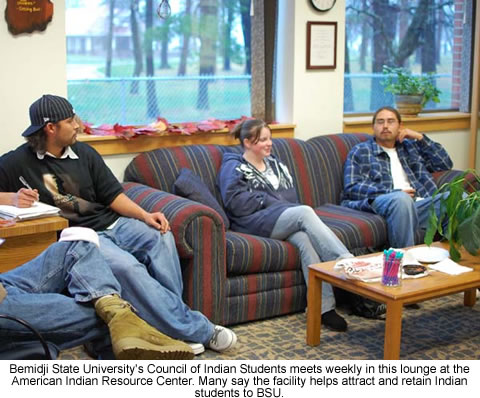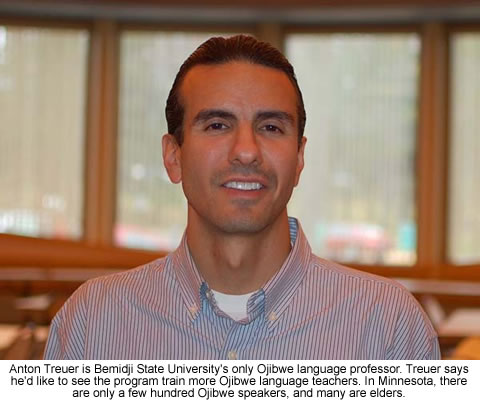 |
Canku Ota
|
 |
|
(Many Paths)
|
||
|
An Online Newsletter
Celebrating Native America
|
||
|
December 1, 2010 - Volume
8 Number 12
|
||
|
|
||
|
Bemidji College's
Ojibwe Center A Home For Increasing Number Of Indian Students
|
||
|
by Tom Robertson - Minnesota
Public Radio
|
||
|
credits: Photos by Tom
Robertson - Minnesota Public Radio
|
|
Built in 2003 largely with private dollars and contributions from local tribes, the $2.6 million American Indian Resource Center, has become an important gathering place for American Indians. It's also a welcoming presence for Indian students, for whom college can be frightening, said Anna Goldtooth, co-chair of the Council of Indian Students. Goldtooth's mother is a member of the Red Lake Band of Ojibwe. Her father is Navajo. "It's been so helpful to my education, just to be here," said Goldtooth, who studies Indian studies and philosophy. "Everyone is so friendly and welcoming, and it's like this every single day. We're all together, we all sort of gather in the lounge or gather on the computers and joke around and laugh every single day." The center includes a computer lab, high-tech classrooms and a large, circular room for public meetings and cultural gatherings. The Council of Indian Students meets there every week.
Bemidji is surrounded by Minnesota's three largest Indian reservations. But the university has struggled to attract and retain Indian students. Enrollment peaked in the 1970s at around 300, but dropped to less than 100 in the 90s. Don Day, a Leech Lake Band member and director of BSU's American Indian Resource Center, said because Indian students can come from low income backgrounds, they struggle adjusting to college. Day says the center helps them make the transition. "There's great pride in our language, in our culture, in our ceremonies, in the things we have always done," Day said. "People are much more confident and they're getting that here ... We're narrowing the gap, but it's going to take a little while."
Day hopes to someday expand the center and make it a national research repository for American Indian academic journals and literature. He envisions a museum to house BSU's extensive collection of Indian artifacts, clothing and jewelry. That collection has been in storage for decades. Others have their eye on the center as a way to help save the Ojibwe language. "I think we're at the tip of the iceberg for what we could do academically," said Anton Treuer, BSU's only Ojibwe language professor. Treuer is involved in efforts to revive the language. In Minnesota, there are only a few hundred fluent speakers.
"There's a growing interest in Ojibwe language revitalization," Treuer said. "A number of emersion schools have been popping up, including one at Leech Lake ... and they need teachers and they need them trained, so we need to develop successful second language learners. This should be our niche for the entire university and should be a growth area." Hopes of expanding the role of the American Indian Resource Center are tempered by a stark financial reality. BSU administrators say they need to cut $5 million from the budget by next spring. Center supporters say their best hope is to expand using private funding.
|
|
|
||
|
|
||
| Canku Ota is a free Newsletter celebrating Native America, its traditions and accomplishments . We do not provide subscriber or visitor names to anyone. Some articles presented in Canku Ota may contain copyright material. We have received appropriate permissions for republishing any articles. Material appearing here is distributed without profit or monetary gain to those who have expressed an interest. This is in accordance with Title 17 U.S.C. Section 107. | ||
|
Canku Ota is a copyright ©
2000, 2001, 2002, 2003, 2004, 2005, 2006, 2007, 2008, 2009, 2010
of Vicki Barry and Paul Barry.
|
||
 |
 |
|
|
The "Canku
Ota - A Newsletter Celebrating Native America" web site and
its design is the
|
||
|
Copyright ©
1999, 2000, 2001, 2002, 2003, 2004, 2005,
2006, 2007, 2008, 2009, 2010
of Paul C. Barry.
|
||
|
All Rights Reserved.
|
||
 Bemidji,
MN — A unique center at Bemidji State University could become
a national home for Ojibwe language and cultural education.
Bemidji,
MN — A unique center at Bemidji State University could become
a national home for Ojibwe language and cultural education.  Goldtooth
is one of about 200 Indian students at BSU. That's about 15 percent
more students than just a few years ago. Still, American Indians
have the lowest college enrollment rates of any ethnic group in
the country.
Goldtooth
is one of about 200 Indian students at BSU. That's about 15 percent
more students than just a few years ago. Still, American Indians
have the lowest college enrollment rates of any ethnic group in
the country. American
Indian enrollment may be up because overall student enrollment is
up nationwide because of the struggling economy. The growing popularity
of tribal colleges also has meant an increase in Indian students
transferring to four-year universities like BSU.
American
Indian enrollment may be up because overall student enrollment is
up nationwide because of the struggling economy. The growing popularity
of tribal colleges also has meant an increase in Indian students
transferring to four-year universities like BSU.  BSU
was the first university in the country to offer Ojibwe back in
1971. Treuer said it's time to expand the program to train certified
Ojibwe language teachers.
BSU
was the first university in the country to offer Ojibwe back in
1971. Treuer said it's time to expand the program to train certified
Ojibwe language teachers. 